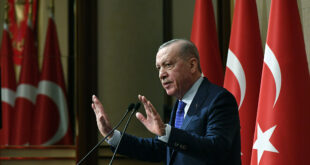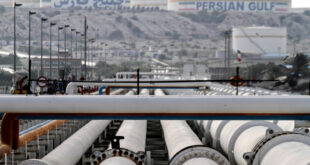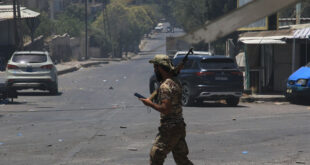At present, Iran is struggling mightily with Western sanctions and the resulting economic pressures due to its nuclear program. With the killing of 22-year-old Mahsa Amin, the country has witnessed widespread protests and violence (Al Jazeera, September 27). Regarding nuclear negotiations with the West, some interpret Iran’s activism as treading on Russia’s toes. Some also claim that Iran’s foreign policy stance has been rather passive and argue that its role in trying to mediate the conflict in Ukraine has served to elevate disputes between the United States and Russia (Radiofarda.com, September 4). Even before the war, Iranian-Ukrainian relations had faced serious tension following the downing of a Ukrainian plane by the Islamic Revolutionary Guard Corps (IRGC) in January 2020.
Despite Iran’s economic problems, the authorities in Tehran have still defined security issues as their top priority. On July 19, Russian President Vladimir Putin, in his second foreign trip following Russia’s military attack on Ukraine on February 24, visited Tehran to meet with government officials. Considering what has happened in Ukraine in recent months, many capitals in the world are not willing to roll out the red carpet for the head of the Kremlin (Eurnews.com, July 22). No major developments directly affected bilateral relations between Moscow and Tehran following Putin’s visit, although he was successful in securing the support of the Supreme Leader regarding Russia’s invasion of Ukraine. Ayatollah Ali Khamenei clearly voiced support for Russia stating, “If you had not taken the initiative, the opposite side would have caused [the outbreak] of war.” In August 2022, a US official told CNN: “Over the past few weeks, Russian officials have been training in Iran as part of the agreement to transfer drones from Iran to Russia.” This official said that the information related to the training of Russian officers in Iran was recently declassified (CNN, August 9). As a result, Iran has made it clear that agreement with Russia relating to “new technology” predates the war against Ukraine (Rusi.com, July 22).
In August 2022, Russia received the first shipments of Iranian-made combat drones in Ukraine. Washington believes this was a move to strengthen relations between Tehran and Moscow and boost Russia’s overstretched military forces. Russian forces do not have many attack drones, although they do have access to unmanned aerial vehicles (UAVs) for surveillance purposes. For its part, Ukraine has used Turkish-manufactured UAVs since the conflict began (Farazdaily.com, July 17). Ukrainian military officials announced on September 13 that, for the first time, they shot down an Iranian Shahed-136, or “kamikaze” drone, on the battlefield in Kupyansk region.
Iran’s suicide drones were sent to Russia at a time when members of the presidential cabinet had repeatedly announced they were ready to mediate between Russia and Ukraine. In July 2022, Iranian Foreign Minister Hossein Amir-Abdollahian, in a phone conversation with Ukrainian Foreign Minister Dmytro Kuleba, announced Tehran’s readiness to comprehensively develop relations with Kyiv. Pointing out that the Islamic Republic is continuing its efforts to end the war, Abdollahian added that Tehran is ready to expand relations with Kyiv in the economic and agricultural sectors (Mashreghnews.ir, July 30).
As numerous reports have demonstrated, Russia has increasingly been using Iranian-made UAVs in combat operations against Ukraine. Oleksiy Arestovych, adviser in the Office of the President of Ukraine, announced on August 5 that the Islamic Republic of Iran has delivered 46 drones to Russia. According to these reports, at least some of the drones delivered to Russia are the older generation of Shahed-129 combat drones, which Russian forces may use to attack the M142 High-Mobility Artillery Rocket Systems (HIMARS) in Ukraine. (Understandingwar.org, August 5).
Recent skirmishes have seen Russia use both Shahed- and Mohajer-class combat drones in Ukraine, and it is reported that these drones originated in Iran. The drones had an initial devastating impact on Ukraine, destroying infrastructure and armored vehicles, and causing damage to the port of Odesa. Yet, as the conflict has dragged on, these drones’ effectiveness has diminished rapidly. Ukraine claimed its forces had shot down one of these drones for the first time last month. Since then, many more drone attacks have been reported. Kyiv’s military said on October 12 alone it had downed 17 Shahed-136 drones. According to photos released by Ukrainian authorities, Russia has rebranded the Shaheds under the name “Geran” (The Kyiv Independent, October 17). The Ukrainian Air Force stated that the downed drones were Shahed-136 kamikaze drones and Mohajer-6 drones used for surveillance and munition carrying. As these drones are small, they are beneficial to the Russian army. Due to their size and ability to operate at low altitudes, these drones can avoid detection by Ukrainian radar systems. Ukrainian forces are quite adept at bringing these drones down during the day but struggle to combat them at night, as US-supplied Stinger anti-aircraft missiles do not come with a night-vision system (Sharghdaily.com, accessed October 12).
On September 24, Kyiv cancelled the accreditation of the Iranian ambassador to Ukraine, Manouchehr Moradi, on the grounds that Iran had supplied weapons to Russia. In a written statement, Iranian Foreign Ministry spokesperson Nasser Kanaani announced that Tehran will respond appropriately to the decision in due course. In the statement, Kanaani expressed his regret over Ukraine’s decision to damage diplomatic relations with Iran and said that “the decision was based on unconfirmed news of foreign media outlets.” Arguing that his country is following a policy of neutrality in the war between Ukraine and Russia, Kanaani said that the disagreements between Kyiv and Moscow should be resolved far away from the violence. He remarked that this issue should be resolved through political dialogue and that Abdollahian has been frequently in contact with his Russian and Ukrainian counterparts (Ulusal.com, September 24).
Even so, Tehran has not yet given a convincing answer to Kyiv on the downing of the Ukrainian passenger plane in January 2020. If the revised nuclear agreement is signed and if the current foreign policy of the Islamic Republic continues, which is based on creating tension with its neighbors, this will lead to the loss of opportunities for Tehran. Neutrality in the war against Ukraine was an opportunity for Iran to play an integral role in regional security and potentially the reconstruction of Ukraine (Radiofarda.com, January 11, 2021). Now, those prospects look increasingly dim.
Iran’s foreign policy during Ebrahim Raisi’s presidency has placed an emphasis on securing national interests and adjusting actions within this indicator. On this basis, from dialogue with the West to the expansion of interaction with Russia and China, each strategy is undergirded using all available national capacities to solve problems. However, the recent tension in relations between Tehran and Kyiv show that Iran is struggling to effectively implement its foreign policy (Irna.ir, February 8, 2021). Although Iran has repeatedly denied sending drones to Russia, due to the continuation of Western sanctions, Tehran is trying to improve its relations with Moscow, and in recent days, Iran’s oil minister has expressed readiness to import Russian natural gas and swap it to neighboring countries. Thus, Tehran is expanding its relations with Moscow, whereas there is no true indication of Tehran’s willingness to improve relations with Kyiv.
 Eurasia Press & News
Eurasia Press & News




